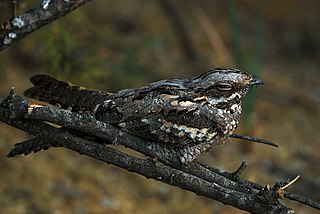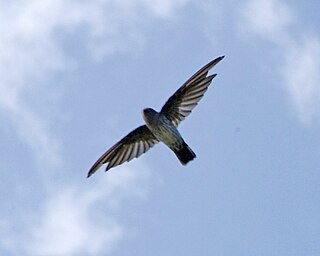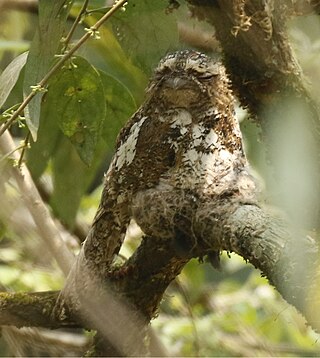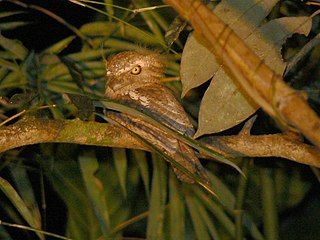
The European nightjar, common goatsucker, Eurasian nightjar or just nightjar, is a crepuscular and nocturnal bird in the nightjar family that breeds across most of Europe and the Palearctic to Mongolia and Northwestern China. The Latin generic name refers to the old myth that the nocturnal nightjar suckled from goats, causing them to cease to give milk. The six subspecies differ clinally, the birds becoming smaller and paler towards the east of the range. All populations are migratory, wintering in sub-Saharan Africa. Their densely patterned grey and brown plumage makes individuals difficult to see in the daytime when they rest on the ground or perch motionless along a branch, although the male shows white patches in the wings and tail as he flies at night.

The frogmouths (Podargidae) are a group of nocturnal birds related to owlet-nightjars, swifts, and hummingbirds. Species in the group are distributed in the Indomalayan and Australasian realms.

The Sri Lanka frogmouth, Sri Lankan frogmouth or Ceylon frogmouth is a small frogmouth found in the Western Ghats of south India and Sri Lanka. Related to the nightjars, it is nocturnal and is found in forest habitats. The plumage coloration resembles that of dried leaves and the bird roosts quietly on branches, making it difficult to see. Each has a favourite roost that it uses regularly unless disturbed. It has a distinctive call that is usually heard at dawn and dusk. The sexes differ slightly in plumage.

The Philippine frogmouth is a nocturnal bird that can be found throughout the Philippine archipelago. It is common in lowland forests and maturing second growth. There is little information about the bird. It feeds on grasshoppers, cicadas, crickets and beetles.

The cave swiftlet or linchi swiftlet is a species of swift in the family Apodidae. It is found on the Indonesia islands of Sumatra, Java and Bali. It is a woodland species and nests in caves. The Bornean swiftlet was considered a subspecies, but is now usually considered distinct.

Bates's nightjar or the forest nightjar, is a bird species of the family Caprimulgidae, found in the rainforests of western Sub-Saharan Africa.

The silky-tailed nightjar is a species of nightjar birds in the family Caprimulgidae. It is found in Brazil, Argentina, Bolivia, Paraguay, and Peru. Its natural habitat is subtropical or tropical moist lowland forests.

The spotted nightjar or spotted eared-nightjar is a species of nightjar in the family Caprimulgidae. It inhabits much of mainland Australia and has also been found in several Indonesian islands. Its natural habitats are open forests and woodlands, scrub, spinifex and tussock grassland, savannah woodland and mangroves.

The barred owlet-nightjar is a species of bird in the owlet-nightjar family Aegothelidae. It is found in New Guinea. The species was originally thought to be the same species as the Australian owlet-nightjar, until that species was found within the range of the barred owlet-nightjar. It was also considered to be the same species as the Vogelkop owlet-nightjar. There are three subspecies, the nominate, from south-eastern New Guinea, A. b. wiedenfeldi from northern New Guinea, and A. b. plumifer from the D’Entrecasteaux Islands.

Blyth’s frogmouth is a species of bird in the family Podargidae. It was previously considered to be conspecific with the Javan frogmouth and Palawan frogmouth. The bird is a tropical species that ranges from India to Australia.

The large frogmouth is a species of bird in the family Podargidae. It is found in Brunei, Indonesia, Malaysia, and Thailand, in subtropical or tropical moist lowland forest. Logging of its habitat poses a risk to its survival, and the International Union for Conservation of Nature has listed it as being "near-threatened".

The Dulit frogmouth is a little-known species of bird in the frogmouth family, Podargidae, with a patchily recorded distribution in the mountain forests of northern and central Borneo to which it is endemic. The species is monotypic.

Hodgson's frogmouth is a species of bird in the family Podargidae. It is found in Bangladesh, Bhutan, China, India, Laos, Myanmar, Thailand, and Vietnam. Its natural habitat is temperate forests.

The Sumatran frogmouth, also known as the short-tailed frogmouth and the pale-faced frogmouth, is a nocturnal bird belonging to the family Podargidae. It is endemic to the island of Sumatra in Indonesia.

Gould's frogmouth is a nocturnal species of bird in the order Caprimulgiformes and the family Podargidae. It is one of the 12 species in the Batrachostomus genus. Its common name commemorates the English ornithologist and bird artist John Gould (1804-1881).

The Javan cuckooshrike is a species of bird in the family Campephagidae. It is endemic to the island of Java in Indonesia. Its natural habitat is subtropical or tropical moist lowland forest.

The Palawan frogmouth is a species of bird in the family Podargidae. It is found on Palawan in the Philippines. Its natural habitat is subtropical or tropical moist lowland forest. It is sometimes considered conspecific with the Javan and Blyth's frogmouth.


















